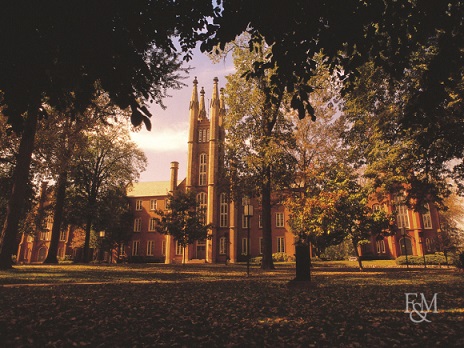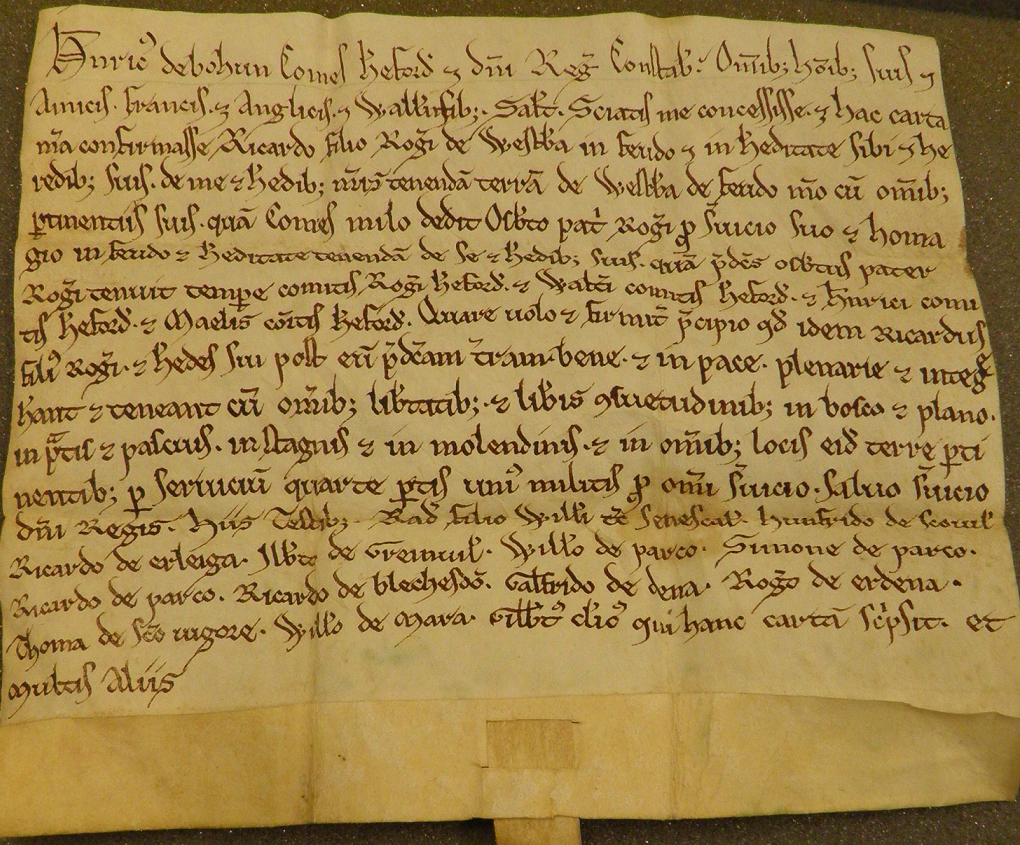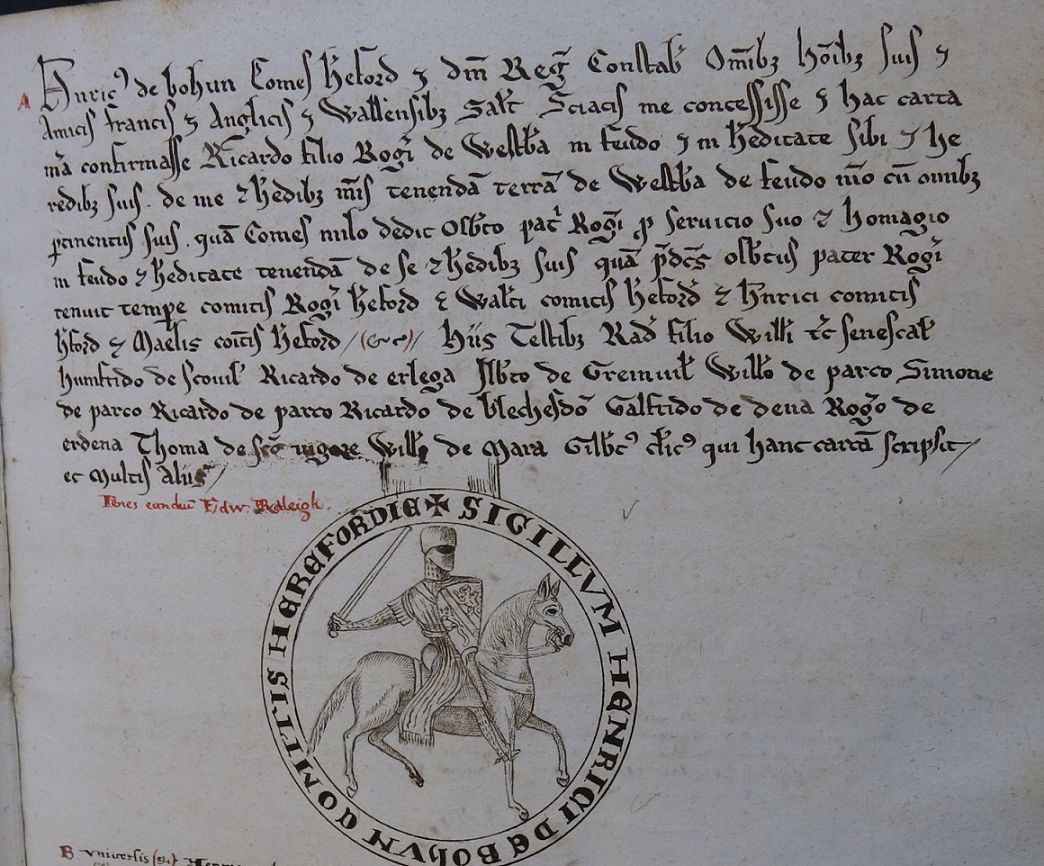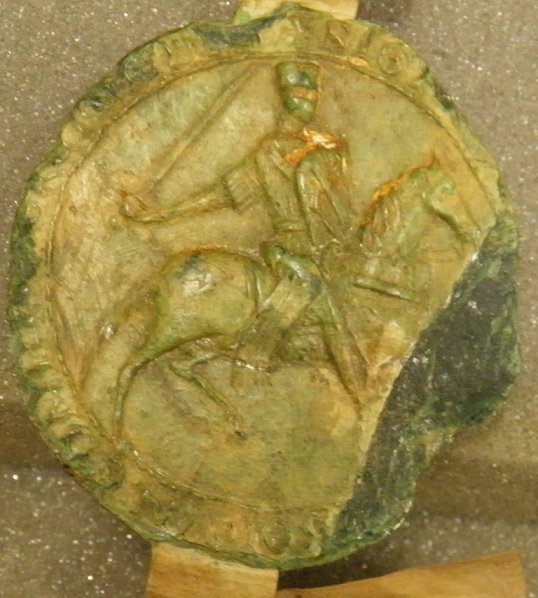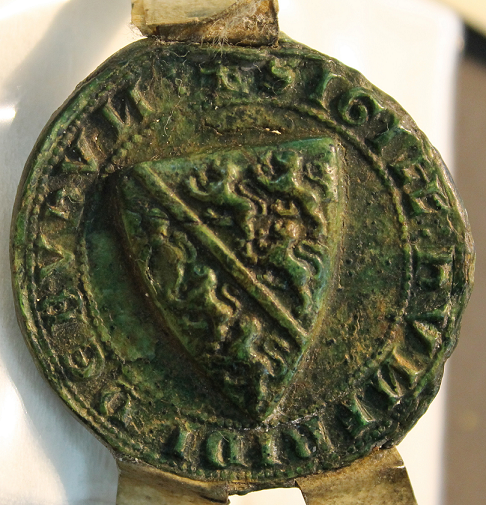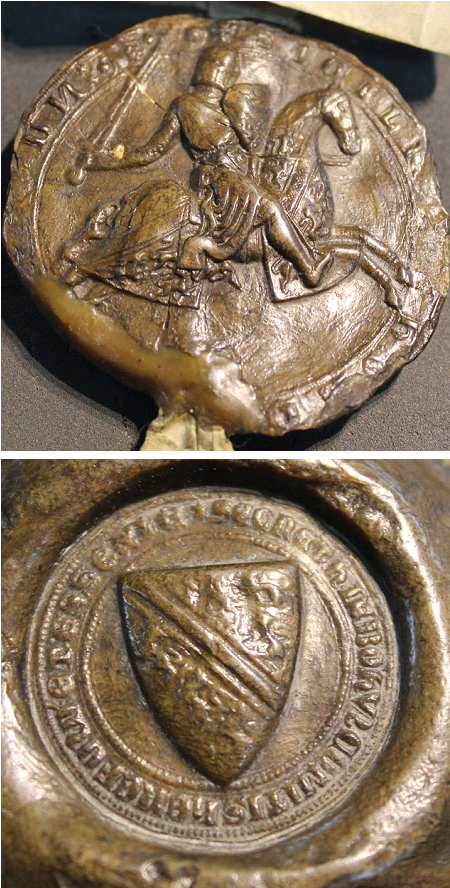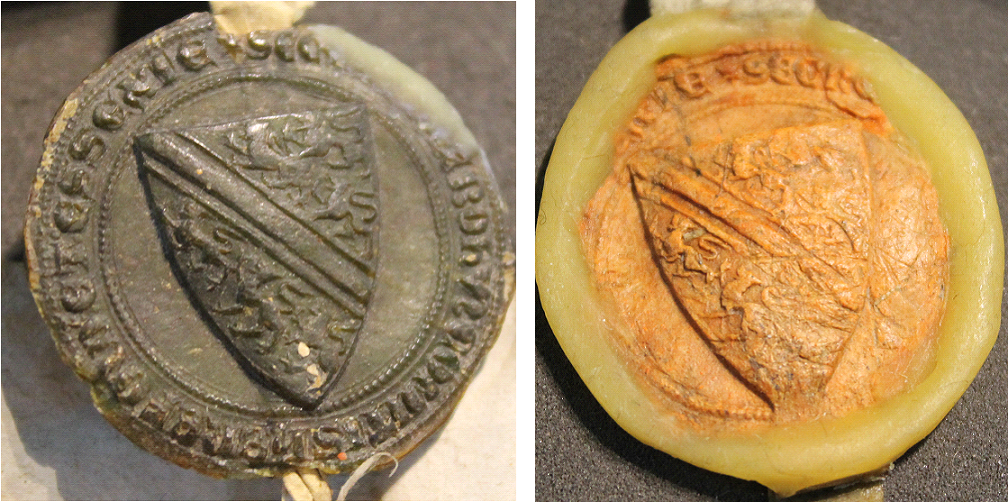A Magna Carta Relic in Pennsylvania: Henry de Bohun, Earl of Hereford, and the Heraldry of Runnymede
April 2015,
Last Thursday, 9 April, I gave a lecture on Magna Carta, at Franklin and Marshall College in Lancaster, Pennsylvania. Founded in 1787 with a gift of £200 from Benjamin Franklin, and in 1853 merged with Marshall College (established since 1836 at Mercersburg, Pennsylvania), Franklin and Marshall is a well-respected liberal arts college. Its members gather each week for a lunchtime lecture of general interest, known as 'Common Hour'. Last Thursday, about forty minutes before I was due to speak, I asked my host, Professor Ben McRee, whether the College had any medieval manuscripts. 'A few', he said. 'Any charters?'. 'A collection of autographs'. By this time, we were strolling past the Science Library, where the manuscripts are kept, so on the off chance we went in and asked the library assistant, Mike Lear, whether there was a list. A glance at this, a speedily pencilled order form, and five minutes later, Mike had reappeared with the charter printed below. The charter itself is not unknown. It was seen by Sir William Dugdale in 1638, amongst the manuscripts of Sir Edward Raleigh of Farnborough Hall in Warwickshire. Dugdale's copy is now in the Bodleian Library at Oxford.1 Photographs of the original and its seal were deposited in the Gloucestershire Record Office in the 1970s, at the time of the charter's export to Pennsylvania.2 However, the survival of the original gives cause for celebration. Not only did it add a splendidly unexpected note of local colour to my Franklin and Marshall lecture, but both it and its seal establish details that Dugdale's copy either omitted or left uncertain.
The charter, as it survives, carries a printed slip, listing it as no.69, apparently from the catalogue of a book dealer, with an asking price of £550. To judge from its pencilled endorsement, it was bought in 1975. Its purchaser was Herbert H. Rawnsley (1919-2004), an autograph collector who had graduated from Franklin and Marshall College in 1940 before pursuing a successful medical career, first as a Captain in the US Army Medical Corps, then as an obstetrician at the Washington Hospital, Washington Pennsylvania.3 Dr Rawnsley collected autographs over many years, ranging from those of American notables and kings and queens of England, through to Goebbels, Himmler and Hitler. His collection was donated to Franklin and Marshall in 2001.4
The charter, previously unpublished, represents an important link in our chain of evidence for a portion of the manor of Westbury-on-Severn in Gloucestershire recorded later as a quarter fee under Bohun family overlordship. The main part of Westbury-on-Severn seems to have restored to the crown following the death of Roger earl of Hereford (d.1155) and was thereafter granted by Henry II to Roger de Mynors. In 1217, it was partitioned between the three daughters of Roger's grandson, Henry de Mynors.5 The present quarter fee, by contrast, can be identified as a distinct portion of Westbury, not restored to the crown after 1155, held in 1303 from the Bohuns by Simon de Solers and Peter Helion, and later known as the manor of Sellars, by the 1530s belonging to Llanthony Priory.6
This portion is first recorded, from the time of Miles of Gloucester, earl of Hereford 1141-3, in the possession of Osbert of Westbury. Osbert occurs as a regular witness to charters of earl Roger of Hereford and his family, from the 1140s through to the time of earl Roger's brothers, Walter and Henry, as late as 1161.7 From earl Roger, whom he served as steward (dapifer), Osbert acquired the land of Broctuna together with land and fisheries on the Severn at Awre, Minsterworth and at Garne in Newnham.8 David Walker, editor of the charters of the earls of Hereford, sought to identify Broctuna as Brockhampton in Bishop's Cleeve, a portion of which was undoubtedly later under Bohun family lordship.9 However, it seems more plausible that the Broctuna of earl Roger's charter is to be identified as that portion of Westbury-on-Severn later held by Osbert's son and grandson. Certainly the place-names Boughton (now Poultonshill) and Broughtons Wood, both within the manor of Westbury, support this theory.10 Osbert served as sheriff of Gloucestershire in 1154-5 and perhaps from some time before this.11 From Michaelmas 1165, coinciding with the extinction in the male line of his lords, the sons of Miles of Gloucester, he was amerced 100 marks at the King's Exchequer, paid off in regular instalments over the next ten years, until at Michaelmas 1175 the small outstanding balance was dropped from the Exchequer's accounts, perhaps coinciding with Osbert's death.12 His son, Roger of Westbury, appears as a witness for Margaret de Bohun, earl Roger's sister, into the 1190s and was confirmed by her in possession of land at Westbury that, according to Margaret, had first been granted to Roger's father, Osbert, by earl Miles, this land being now assessed for service as one quarter of a knight's fee.13 Roger of Westbury is last recorded in 1200.14 His son, Richard, the beneficiary of our newly discovered charter, makes only a fleeting impression on the records, in the present charter, and as witness to a charter of Margaret de Bohun, before 1197.15
The date of our charter is difficult to determine, save that it must fall within the period of Henry's rule as earl, between 1200 and his death in 1220. Nonetheless, its address to Henry de Bohun's French, English and Welsh subjects may suggest a grant made before or only shortly after King John's loss of Normandy in 1204. Thereafter, addresses to Frenchmen swiftly disappear. The witnesses and the script would likewise suit a date close to 1200, in October of which year, the King himself visited Westbury-on-Severn, en route from Gloucester to St Briavels.16 Beyond its usefulness as a record of land ownership, there are at least two further points of interest to the Franklin and Marshall charter.
Firstly, and most significantly, it carries what seems to be the earliest surviving seal of a Bohun earl of Hereford. The Bohun arms were in due course recorded by Matthew Paris as Azure, a bend argent cotised or between six lions rampant or.17 The arms shown on the present seal, by contrast, seem to represent an earlier, indeed the very earliest version of this coat, here as a bend between two (rather than six) lions rampant. It was presumably these arms that Henry de Bohun carried onto the field of Runnymede as one of the twenty-five barons of Magna Carta. Meanwhile, and as pointed out to me by Adrian Ailes, the seal design is sufficiently close both in date and proficiency to that of the design of the great seal of King John that we might speculate that both seals were made by the same goldsmith. Whether the two lions of the present shield represent a definitive record of the Bohun arms, or merely result from the inability of the engraver to represent six lions on a very small shield, remains uncertain. Certainly, in due course six lions became standard on the seals of Henry's son and great-grandson, both named Humphrey de Bohun, the son earl of Hereford from c.1225 to 1275, the great-grandson earl from 1275 to 1298. Humphrey, the second Bohun earl (d.1275), seems to have employed at least two seals.
Perhaps the earliest of these (right), approximately 40mm.in diameter, is attached to a charter relating to land at Bisley in Gloucestershire in which Humphrey (as earl of both Hereford and Essex, so after 1236) displays a shield of arms, a bend between six lioncels (or lions rampant) and a legend identifying its owner merely as Humphrey de Bohun, without either of his comital titles and so potentially a seal first made for him in the 1220s, before his accession as earl of Hereford.18
Attached to another charter of Humphrey (d.1275), of the 1250s or 60s in favour of his younger sons, Miles and John de Bohun, we find a different, double-sided seal (left) that can only have been used by him after 1236, when he added the title earl of Essex to his existing title as earl of Hereford. On the obverse, this shows a mounted warrior. Beneath him is a bifurcated tree (perhaps to signify his two earldoms). The arms on the warrior's shield are too rubbed to allow certain identification, but the counterseal, of the same basic dimensions as the obverse (approx. 63mm. in diameter), carries a shield of arms, a bend cotised between six lioncels (or lions rampant), above it an eight-pointed star. Left and right of it are displayed two smaller shields, now rubbed and illegible, but said by Walter de Gray Birch to have carried the arms of the Fitz Peter earls of Essex, Humphrey's maternal kin.19 It has been suggested in the past that the cotised bend represents an attempt to combine the Bohun arms with those previously borne by Miles of Gloucester and his sons as royal constables. More likely, the cotised bend (with parallel outline) is intended, like the shields on the reverse, and the bifurcated tree, to represent the merging of the earldoms of Hereford and Essex, after 1236.
Humphrey's grandson, the third Bohun earl of Hereford (d.1298), can be found in the 1270s employing a seal (right), approx. 60mm. in diameter, that shows him mounted carrying a shield, a bend between ?two lions rampant, but with two sets of three lioncels on the surcoat over the horses neck and two further sets of three lioncels on the horse's rump, with a smaller counterseal, approx. 28mm. in diameter, displaying a shield of arms, a bend cotised between six lioncels, this counterseal itself employed elsewhere to seal others of Humphrey's writs and charters (below).20
Our charter also offers significant indications of what Henry de Bohun (d.1220) believed to be his hereditary claims to the earldom of Hereford. This had first been created in 1141 for Miles of Gloucester, whose daughter, Margaret (d.1196/7) married Humphrey II de Bohun (d.1164/5) lord of Trowbridge in Wiltshire. The earldom passed to Miles' eldest son, Roger earl of Hereford, who died in 1155 without issue. Thereafter, for the next 45 years, no earl was officially recognized, even though earl Roger's three brothers, Walter, Henry and Mahel, all outlived him.21 King John's charter of 28 April 1200, granting Henry de Bohun the third penny of pleas and recognizing him as earl, was specifically framed as a new creation rather than as a simple inheritance, and was made only in return for Henry's resignation of various property previously claimed by earl Roger (d.1155).22 By contrast, in the present charter Henry de Bohun specifically refers to all four of his great-uncles, Roger (d.1155), Walter (d.c.1160), Henry (d.1165) and Mahel (d.1165), as 'earls' of Hereford, apparently as a means of emphasizing his own claims to succession by right and inheritance rather than by royal favour.23 Here our charter breaks with the tradition established by Margaret de Bohun, Henry de Bohun's grandmother, which had confirmed the Westbury estate to Roger of Westbury, Richard's father, as granted by earl Miles and as enjoyed in the time of earl Roger, Walter, Henry and Mahel of Hereford, referring to Walter, Henry and Mahel without any claim that they had borne title as earls.24
Henry de Bohun's grievances against King John were to lead him, in 1215, into open alliance with the rebels. Harassed by the King's half-brother, William earl of Salisbury, over his rights to the honour of Trowbridge, he was already closely related to a number of baronial malcontents. By birth, he was uncle to the murdered Arthur of Brittany, and nephew to William the Lion, King of Scotland. By his marriage to Maud, a daughter of Geoffrey fitz Peter, he became brother-in-law to Geoffrey and William de Mandeville, both of them in due course his fellow members of the baronial twenty-five.25 In 1215, the Crowland chronicler reports the raising of the baronial standards (vexilla) at Northampton.26 How remarkable that our knowledge of one of these standards, bearing the Bohun arms, later carried onto the field of Runnymede, should come to us from a record that has previously slumbered unnoticed in rural Pennsylvania.
APPENDIX
Notification by Henry de Bohun, earl of Hereford and constable of the King, of his grant in hereditary fee to Richard son of Roger of Westbury of the land in Westbury-on-Severn (Gloucestershire) that earl Milo gave to Osbert, Roger's father, and that Osbert held in the time of earl Roger of Hereford, earl Walter of Hereford, earl Henry of Hereford, and earl Mahel, to hold in perpetuity for the service of a quarter fee, saving service owed to the King. [1200 X 1220, ?c.1200]
A = Lancaster, Pennsylvania, Franklin and Marshall College ms.50 (Herbert H. Rawnsley Collection) OS3. Approx. 178 X 140 + 15mm. Endorsed: Ley & West (s.xv); Westbury co. Glouc. s.d. (s.xviii/ix); 5/11/75 a/aoo (pencil, apparently sale marks c.1975). Sealed sur double queue, parchment tag through 3 slits, seal impression in green wax, round (c.65mm. diameter), green wax, fine impression of a knighted warrior riding left to right, sword brandished in right hand, the right arm with mail sleeve terminating above the elbow, shield in left hand displaying arms, a bend between two lions rampant, legend SIGI<LLVM HENRICI DE> BOHVN COMITIS HEREFORDIE+, the letters in brackets here supplied from the drawing by Dugdale (B below). Attached is a printed dealer's catalogue notice, item no.69, with an asking price of £550. B = Oxford, Bodleian Library ms. Dugdale 17 p.71, accurate fascimile copy by Dugdale with drawing of seal, from an original then in the possession of Sir Edward Raleigh of Farnborough, 1638. Dugdale deliberately omits the whole of the corroborative clause beginning 'Quare volo', resuming with the witness list. C = Gloucester, Gloucestershire Archives D3360/1, a xerox of the charter and photographs of the seal, apparently produced as part of the export arrangements in 1975.
Henricus de Bohun comes Hereford' et domini reg(is) constab(ularius) omnibus hominibus suis et amicis Francis et Anglicis et Wallensibus salutem. Sciatis me concessisse et hac carta m(e)a confirmasse Ricardo filio Rogeri de Westbera in feudo et in hereditate sibi et heredibus suis de me et heredibus m(e)is tenendam terram de Westbera de feudo m(e)o cum omnibus pertinentiis suis quam comes Milo dedit Osberto patri Rogeri pro seruicio suo et homagio in feudo et hereditate tenendam de se et heredibus suis quam predictus Osbertus pater Rogeri tenuit tempore comitis Rogeri Hereford' et Walteri comitis Hereford' et Henrici comitis Hereford' et Maelis comitis Hereford'. Quare volo et firmiter precipio quod idem Ricardus filius Rogeri et heredes sui post eum predictam terram bene et in pace, plenarie et integre h(abe)ant et teneant cum omnibus libertatibus et liberis consuetudinibus in bosco et plano, in pratis et pascuis, in stagnis et in molendinis et in omnibus locis eidem terre pertinentibus per seruicium quarte partis unius militis pro omni seruicio, saluo seruicio domini regis. Hiis testibus: Rad(ulfo) filio Will(elm)i tunc senescal(lo), Hunfrido de Scouil', Ricardo de Erleiga, Ilberto de Greinuil', Will(elm)o de Parco, Simone de Parco, Ricardo de Parco, Ricardo de Blechesdon, Galfrido de Dena, Rogero de Erdena, Thoma de Sancto Vigore, Will(elm)o de Mara, Gilbertus clericus (sic) qui hanc cartam scripsit, et multis aliis.
1 | Oxford, Bodleian Library ms. Dugdale 17 p.71. For the descent of the manor of Farnborough, see VCH Warwickshire, v, 84-6; Sir William Dugdale, The Antiquities of Warwickshire (London, 1656), 403. |
2 | Gloucester, Gloucestershire Archives D3360/1. |
3 | See the notice of his death, at <http://classified.post-gazette.com/details_obits.asp?id=10472876> |
4 | There is an outline listing available at <http://library.fandm.edu/archives/mscoll/rawnsley.pdf> |
5 | VCH Gloucestershire, x, 85-8; RLC, i, 345; Pipe Roll 3 John, 46. |
6 | VCH Gloucestershire, x, 88; Feudal Aids, ii, 250, 284. |
7 | As Osbert of Westbury, he witnesses charters of earl Roger of Hereford, 1143 X 1155 ('Charters of the Earldom of Hereford 1095-1201', ed. David Walker, Camden Miscellany XXII, Camden 4th series i (1964), 19 no.11, 25 no.27, 28 no.36, 36 no.56), and earl Roger's brothers, Walter and Henry of Hereford (Ibid., 44 no.49, 46 no.73, 48 no.78). As Osbert of Westbury he witnesses a further four charters of earl Roger not previously noticed by Walker: TNA E 159/101 m.177d; BL ms. Harley 6187 fos 16r-v, 18v. Even earlier than this, an Osbert priest of Westbury occurs as witness to a settlement involving Winchcombe Abbey, 1115 X 1122: Landboc sive registrum monasterii beatae Mariae virginis et sancti Cenhelmi de Winchelcumba, ed. D. Royce, 2 vols (Exeter 1892-3), i, 212 (after the accession of Theulf bishop of Worcester, and before the death of Girmund abbot of Winchcombe). It is perhaps he, rather than the later Osbert (still living in the 1170s) who witnesses a charter of Walter of Gloucester, c.1123 X 1125 ('Hereford Charters', ed. Walker, 38 no.60, there dated to 1095, in reality from the 1120s, as noted by Julia Barrow in EEA, vii, 11-12 no.10). |
8 | 'Hereford Charters', ed. Walker, 34 no.35, from an original in 1964 belonging to the Robinson Trust, since sold (for £180), Sotheby's ('Bibliotheca Phillippica' part 8, Tuesday 4 July 1972, lot 1744), now Gloucester, Gloucestershire Archives D2783/1, and for Awre and Garne, cf. VCH Gloucestershire, v, 24; x, 44. The charter is witnessed by William of Berkeley (apparently d.1148/9, cf. R.H.C. Davis, 'Treaty Between William Earl of Gloucester and Roger Earl of Hereford', A Medieval Miscellany for Doris Mary Stenton, ed. P.M. Barnes and C.F. Slade, Pipe Roll Society n.s. xxxvi (1962), 144), and so can be dated 1143 X 1149. For Osbert's appearance with title as steward on at least four occasions, see 'Hereford Charters', ed. Walker, 25 no.27, 36 no.56; BL ms. Harley 6187 fo.16r-v. |
9 | 'Hereford Charters', ed. Walker, 34n., and for Brockhampton in Bishop's Cleeve, see VCH Gloucestershire, viii, 11. |
10 | A.H. Smith, The Place-Names of Gloucestershire, 4 vols., English Place-Name Society (1964-5), iii, 204-5. |
11 | The Red Book of the Exchequer, ed. H. Hall, 3 vols. (1896), ii, 650. |
12 | Pipe Rolls 11 Henry II, 13; 12 Henry II, 78; 13 Henry II, 143; 14 Henry II, 122; 15 Henry II, 113; 16 Henry II, 75; 17 Henry II, 85; 18 Henry II, 120; 19 Henry II, 152; 20 Henry II, 22; 21 Henry II, 160. The largest single payments were made in the first year 1164-5 (£31) and 1169-70 (£15). |
13 | 'Hereford Charters', ed. Walker, 70-1 nos 115-17, 73 no.122, this last, duly confirmed by our charter, known only from the copy by Dugdale in Oxford, Bodleian Library ms. Dugdale 17 p.70. There seems to be no return for Westbury in Margaret de Bohun's response to the 1166 inquest into knight service: Red Book, i, 293-4. |
14 | CRR, i, 13, 363, and cf. his appearance as witness to a charter of Henry de Bohun, future earl of Hereford, before 1200: TNA C 115/77 (Llanthony cartulary) fo.23r. |
15 | 'Hereford Charters', ed. Walker, 68 no.112. The name Richard fitz Roger being a common one, it would be unwise to identify Richard son of Roger of Westbury with the Richard fitz Roger who in 1200 fined one mark for a writ of mort d'ancestor in Oxfordshire: Pipe Roll 2 John, 27. Nor is our Richard son of Roger likely to be the Richard of Westbury who witnessed a charter of Gilbert Foliot, bishop of Hereford, before 1155: EEA, vii, no.106. |
16 | RC, 77b, 78b; Rotuli de Liberate, 8; RLP, Itinerary (30-31 October 1200). For various of the witnesses, compare the appearances of Ilbert/Hilderbert de Greinville, Ralph fitz William, Simon and William de Parco, and Richard of Erleigh as witnesses to others of Henry de Bohun's comital charters recorded in Landboc de Winchelcumba, i, 229, and the Llanthony cartulary, TNA C 115/77 (Llanthony cartulary) fos 58r, 129r-v, 279r. |
17 | 'The Matthew Paris Shields c.1244-59', ed. T.D. Tremlett, in Rolls of Arms Henry III, Aspilogia ii, ed. A. Wagner (London 1967), 19 no.33, here conflating the Paris shield with that displayed on Humphrey's seal (before 1242) in Sir Christopher Hatton's Book of Seals, ed. L.C. Loyd and D.M. Stenton (Oxford, 1950), 222-3 no.323 (cf. below n.19), and cf. 'Matthew Paris Shields', ed. Tremlett, 38 no.9. Tremlett (19 no.33, 62 no.16) notes that Paris elsewhere, and perhaps mistakenly, notices these same arms, without lions, as Or a bend gules cotised sable. For the arms employed on the seals of subsequent Bohun earls of Hereford, see below. |
18 | TNA DL 25/1642. This is apparently identical with the seal described by W. de Gray Birch, Catalogue of Seals in the Department of Manuscripts in the British Museum, 6 vols (London, 1887-1900), ii, 518 no.7529, from a plaster cast (BL Seal Cast lxxxiii.53), tentatively dated 1238, legend SIGIL' HUNFRIDI DE BVHVN, with both Ns reversed. Humphrey is accorded title as earl of Hereford in the witness list to Magna Carta 1225, having been permitted, at the request of his kinsman King Alexander of Scotland, to do homage for his father's lands as early as June 1221: G. E. Cockayne, Complete Peerage of England, Scotland, Ireland, Great Britain and the United Kingdom, ed. V. Gibbs and others (12 vols. in 13, 1912-59), vi, 459-60, citing Patent Rolls 1216-25, 242, 294. The third penny of Herefordshire, however, and with it full recognition as earl, seems to have been withheld from him until at least October 1225: Pipe Rolls 7 Henry III, 186; 8 Henry III, 247-8; N. Vincent, ‘Bohun, Humphrey (IV) de, second earl of Hereford and seventh earl of Essex (d. 1275)’,Oxford Dictionary of National Biography (Oxford, 2004; online edn., May 2010) [http://www.oxforddnb.com/view/article/2775, accessed 17 April 2015] As late as July 1226, Humphrey continues to appear on occasion without title as earl: Patent Rolls 1225-32, 82. |
19 | TNA DL 27/11, the obverse bearing the legend ...GILL.....<COM>ITIS HERFO.....ESSESIE+, the countseal the legend SIGILL......<H>ERFORDIE ET E.....IE+, in accordance with the description (from a cast) supplied by Birch, Catalogue, ii, 252 no.5720, from BL Seal Casts lxxviii.36-7, tentatively dated 1259, with legends obverse SIGILLV' HVMFRIDI De BOVN COMITIS HERFOR....ESSESIE, and reverse SIGILL.....E BOV....OMITIS HERFORDIE ET ESS..IE. This is apparently identical to the seal and counterseal shown in a partial state only in Hatton's Book of Seals, 223 no.323, as suggested by the presence on the Hatton example of a smaller shield next to the larger shield on the counterseal. Birch attributes two other seals to Humphrey (d.1275), the first (Birch, Catalogue, ii, 252 no.5721), from BL Seal Cast lxxviii.38, tentatively dated 1274, a smaller equestrian seal, figure in fur mantle with conical cap, a hawk on his left wrist, approx. 28mm. diameter, legend: S' H' DE BOHVN COMITIS HERF....<E>T ESSEXIE. The second (Birch, Catalogue, ii, 518 no.7530), from BL Seal Cast lxxxiii.54, tentatively dated 1260, armorial, but without shield, a bend charged with fleur-de-lis between six lions rampant, legend SIG....UNFRIDI DE BVVN, approx. 26mm. diameter, beaded borders. In her widowhood, Humphrey's mother, Matilda/Maud (d.1236), widow of Henry de Bohun (d.1220), reverted to her maiden name, styling herself as 'Matilda de Mandeville countess of Essex and Hereford': BL ms. Harley Charter 53.D.1. |
20 | Well preserved on TNA E 42/65, the legend to the obverse suggesting that the equestrian side was first employed by Humphrey before his succession as earl in 1275, SIGILL'....h' D.....VN':+. The counterseal, which carries a post-1275 legend, SECRET' H' DE BOHVI COMITIS HEREFORD' ET ESSEXIE+ (with the VN at the end of BOHVN shown as three rather than four strokes), appears elsewhere as the only seal authenticating TNA DL 25/1444 and DL 25/27. |
21 | Walker, 'Charters of the Earldom of Hereford', 1-6; GEC, Complete Peerage, vi, 454-9. |
22 | RC, 53, 61b, the first of these surviving as an original, now TNA DL 10/52. |
23 | As noted by David Crouch, The Image of Aristocracy in Britain, 1000-1300 (London, 1992), 70-1, from the copy in Oxford rather than from the original now in Lancaster Pennsylvania, and for the brothers' dates of death, 'Hereford Charters', ed. Walker, 9-10. |
24 | 'Hereford Charters', ed. Walker, 73 no.122. |
25 | GEC, Complete Peerage, vi, 457-9, esp p,457 note 'd', and cf. David Walker, 'Henry de Bohun', ODNB. |
26 | Memoriale fratris Walteri de Coventria, ed. W. Stubbs, 2 vols. (London, 1872-73), ii, 219 ('reversi sunt Northamptonam armati, et aciem ordinatam precedentibus vexillis'). The standard-bearer ('vexillifer') of Robert fitz Walter was to be amongst the very first of the baronial army to be killed in the ensuing siege: Roger of Wendover, Flores Historiarum, ed. H.O. Coxe (4 vols., London, 1842), iii, 299. |
Referenced in
The Arms of Roger Bigod (Features of the Month)
'by the law of our realm or by judgment of their peers' (The Itinerary of King John)
'by the law of our realm or by judgment of their peers' (The Itinerary of King John)
- January 2016
Exchange of Letters between King and Rebels - December 2015
Partridges and a Pear Tree - December 2015
The Saving Clause in Magna Carta - December 2015
Christ's College and Magna Carta - November 2015
The Arms of Roger Bigod - October 2015
Ten Letters on Anglo-Papal Diplomacy - September 2015
The Leges Edwardi Confessoris - July 2015
New Letter of the Twenty-Five - July 2015
Runnymede and the Commemoration of Magna Carta - June 2015
Who Did (and Did Not) Write Magna Carta - June 2015
Date of Magna Carta - June 2015
A Lost Engrossment of 1215? - May 2015
A Glimpse of Rebel London - May 2015
The Rebel Seizure of London - May 2015
Papal Letters of 19 March - May 2015
The Copies at Lincoln and Salisbury of the 1215 Magna Carta - May 2015
The copies of Magna Carta 1216 - May 2015
The Magna Carta of Cheshire - April 2015
Dating the Outbreak of Civil War - April 2015
More from the Painter Archive - April 2015
A Magna Carta Relic in Pennsylvania - April 2015
A Lost Short Story by Sidney Painter - April 2015
King John's Banners and Battle Flags - March 2015
King John’s Lost Language of Cranes - March 2015
Magna Carta and Richard II's Reign - March 2015
The King Takes the Cross - February 2015
Irish Fines and Obligations - January 2015
John negotiates with Langton over Rochester - January 2015
Conference at New Temple - December 2014
Simon de Montfort's Changes to Magna Carta - November 2014
Meeting at Bury St Edmunds - October 2014
King John Forgets his Password - September 2014
Treaty 18 September 1214 - September 2014
Letter of King John 9 July 1214 - September 2014
Letter of Aimery Vicomte of Thouars - August 2014
The Freedom of Election Charter - July 2014
The Witness Lists to Magna Carta - April 2014
The Cerne Abbey Magna Carta - March 2014
Confirmation of Magna Carta in 1265
